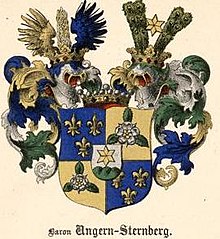Baltic German nobility

The Baltic nobility was the privileged social class in the territories of today's Estonia and Latvia. It existed continuously since the Northern Crusades and the medieval foundation of Terra Mariana. Most of the gentry were Baltic Germans, but with the changing political landscape over the centuries, Polish, Swedish and Russian families also became part of the nobility, just as Baltic German families re-settled in e.g. the Swedish and Russian Empires.[1] The nobility of Lithuania is for historical, social and ethnic reasons often separated from the German-dominated nobility of Estonia and Latvia.
History
This section needs expansion. You can help by adding to it. (January 2013) |
This nobility was a source of officers and other servants to Swedish and Polish kings in 16th and particularly 17th centuries, when Couronian, Estonian, Livonian and Oeselian lands belonged to them. Russian emperors used Baltic nobles in government.
Most of the nobility was "recalled" by Hitler to Germany in late 1939, a few months prior to the annexation of Estonia and Latvia by the Soviet Union in June 1940. Nowadays it is possible to find the successors of the Baltic nobility all around the world.[citation needed]
Manorial system

Rural Estonia and Latvia was to a large extent dominated by a manorial estate system, established and sustained by the Baltic nobility, up until the declaration of independence of Latvia and Estonia following the upheavals after World War I. Broadly speaking, the system was built on a sharp division between the landowning, German-speaking nobility and the Estonian- or Latvian-speaking peasantry. Serfdom was for a long time a defining characteristic of the Baltic countryside and underscored a long-lasting feudal system, until its abolishment in the Governorate of Estonia in 1816, in the Courland Governorate in 1817 and in the Governorate of Livonia in 1819 (and in the rest of the Russian Empire in 1861). Still, the nobility continued to dominate the rural parts of Estonia and Latvia via manorial estates throughout the 19th century. However, almost immediately following the declaration of independence of Estonia and Latvia, both countries enacted far-reaching land reforms which in one stroke ended the former dominance of the Baltic nobility on the countryside.
The manorial system gave rise to a rich establishment of manorial estates all over present-day Estonia and Latvia, and numerous manor houses were built by the nobility. The manorial estates were agricultural centres and often incorporated, apart from the often architecturally and artistically accomplished main buildings, whole ranges of outbuildings, homes for peasants and other workers at the estates and early industrial complexes such as breweries. Parks, chapels and even burial grounds for the noble families were also frequently found on the grounds. Today these complexes form an important cultural and architectural heritage of Estonia and Latvia.[2][3]
For an overview of manorial estates in Estonia and Latvia, see List of palaces and manor houses in Estonia and List of palaces and manor houses in Latvia.
Organization
They were organized in the Estonian Knighthood in Reval, Couronian Knighthood in Mitau, and Livonian Knighthood in Riga. Viborg also had an institution to register rolls of nobles in accordance with Baltic models in the 18th century.
Noble titles in Estonia, Livonia and Couronia
- King: Magnus, King of Livonia, declared during the Livonian War
- Duke: Dukes of Courland or Dukes of Schleswig-Holstein-Sonderburg-Beck, e.g. Peter August, Duke of Schleswig-Holstein-Sonderburg-Beck
- Fürst (usually translated into English as Prince): e.g. Fürst Michael Andreas Barclay de Tolly or Prince Lieven
- Marquis: Philip Osipovich Paulucci
- Count: e.g. Count Joseph Carl von Anrep
- Baron (or the corresponding title of Freiherr): e.g. Baron Henrik Magnus von Buddenbrock
Portrait gallery of Baltic German Nobility from Curonia, Estonia and Livonia
-
Bishop of Riga Albrecht von Buxthoeven, (1165 – 1229)
-
Herman Wrangel, Soldier and politician (1584-1643)
-
Otto Wilhelm von Fersen, Swedish Field Marshal (1623- 1703)
-
Ernst Gideon von Laudon, Austrian Field Marshal
-
Adam Johann von Krusenstern, admiral and explorer
-
Michael Andreas Barclay de Tolly, Russian Field Marshal and Minister of War
-
Fabian Gottlieb von Osten-Sacken, Field Marshal
-
Elisa von der Recke, writer and poet
-
Barbara von Krüdener, religious mystic and author.
-
Karl Ernst von Baer, naturalist, biologist, geologist, meteorologist, geographer, a founding father of embryology
-
Otto Wilhelm von Struve, astronomer
-
Dorothea von Medem, Duchess of Courland
-
Peter Clodt von Jürgensburg, sculptor
-
Alexander Bunge, botanist
-
Alexander Keyserling, geologist and paleontologist
-
Paul von Rennenkampf, general
-
Friedrich Bidder, physiologist and anatomist
-
Alexander von Oettingen, Lutheran theologian and statistician
-
Count Paul von Tiesenhausen
-
Eduard Toll, geologist and Arctic explorer
-
Jakob von Uexküll, biologist,ethologist, cyberneticist and a semiotician
-
Alexander von Middendorff, zoologist and explorer
-
Roman von Ungern-Sternberg, anti-Bolshevik General
-
Pyotr Wrangel, officer in the Imperial Russian army and later commanding general of the anti-Bolshevik White Army in Southern Russia
-
Alexy II of Moscow, Patriarch of Moscow and all Rus', the primate of the Russian Orthodox Church.
See also
- History of Estonia
- History of Latvia
- Baltic Germans
- Baltic knighthoods
- Terra Mariana
- Baltische Landeswehr
References
- ^ von Klingspor, Carl Arvid (1882). "Baltisches Wappenbuch. Wappen sämmtlicher, den Ritterschaften von Livland, Estland, Kurland und Oesel zugehöriger Adelsgeschlechter" (in German).
- ^ Hein, Ants (2009). Eesti Mõisad - Herrenhäuser in Estland - Estonian Manor Houses. Tallinn: Tänapäev. ISBN 978-9985-62-765-5.
- ^ Sakk, Ivar (2004). Estonian Manors - A Travelogue. Tallinn: Sakk & Sakk OÜ. ISBN 9949-10-117-4.
External links
- Bartlett, Roger (1993). "The Russian and the Baltic German nobility in the eighteenth century". Cahiers du Monde Russe et Soviétique. 34 (1–2): 233–243. doi:10.3406/cmr.1993.2349.
- Genealogisches Handbuch der baltischen Ritterschaften, family trees of Baltic nobility in German
- Baltisches Wappenbuch, coats of arms of Baltic nobility
- Estonian Manors Portal, the English version introduces 438 well preserved manors in Estonia, historically owned by the Baltic nobility
































